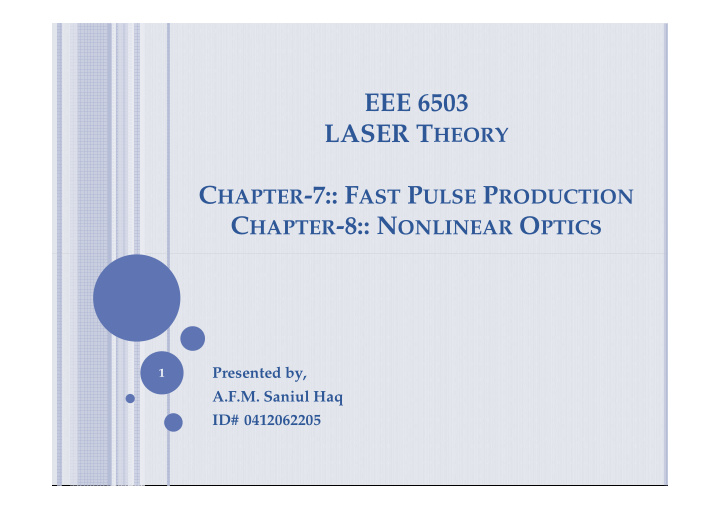



EEE 6503 LASER T HEORY C HAPTER -7:: F AST P ULSE P RODUCTION C HAPTER -8:: N ONLINEAR O PTICS Presented by, 1 A.F.M. Saniul Haq ID# 0412062205
F AST P ULSE P RODUCTION 2
I NTRODUCTION � LASERs are widely used for marking, cutting, drilling. � Works on the principle of vaporizing material � CW LASER tends to heat the surrounding area of target and also can damage substrate. target and also can damage substrate. � Short pulses are best for controlled operation. � Fast, powerful pulses tend to ablate material quickly without heating. � For many operation, the shorter the pulse the better. FAST PULSE PRODUCTION 3
F AST -P ULSE P RODUCTION � Simplest technique envisioned is to switch the gain of the medium on and off. � Its done by switching pump energy on and off. � The problem with the scheme: � Delay for population inversion � Delay for population inversion � Sets limit in the pulse length and repetition time Q-Switching Technique 4
C ONCEPT OF Q-S WITCHING � LASER output is controlled by switching loss in the medium � Also called Loss Switching . � Loss is inserted in the cavity and hence output is spoiled. spoiled. � Q-switch can be thought of as an optical gate blocking optical path 5
I NTRACAVITY S WITCHES • synchronization Rotating Mirror • Linear Q-value • controlled EO or AO switch • Sharp Q-change • organic Saturable dye switch Saturable dye switch • Q varies with lifetime • Q varies with lifetime 6
E NERGY S TORAGE � 7
P OPULATION I NVERSION � 8
P ULSE P OWER AND E NERGY � Lifetime of the photon in cavity Lifetime of the photon in cavity 9
P ULSE P OWER AND E NERGY � 10
P ULSE P OWER AND E NERGY � Integrating constant 11
P ULSE P OWER AND E NERGY � 12
P ULSE P OWER AND E NERGY � 13
P ULSE P OWER AND E NERGY � 14
P ULSE P OWER AND E NERGY � 15
E LECTROOPTIC M ODULATOR � EO modulators works on the principle of birefringence. � Separates incident light ray into two rays that may travel in different direction. � It is also called Double Refraction . � Calcite is natural crystal that exhibits birefringence. Calcite is natural crystal that exhibits birefringence. 16
E LECTROOPTIC M ODULATOR � 17
E LECTROOPTIC E FFECT � Linear EO coefficient Second order EO coefficient 18
E LECTROOPTIC M ODULATOR 19
E LECTROOPTIC M ODULATOR � 20
EO M ODULATOR � Fastest Q-switch :: feature switching time 10ns. � Large hold-of or extinction ratio :: as high as 1000:1 � Suitable EO crystals :: very expensive Driver circuitry :: very critical � High voltage capacitors required 21
A COUSTOOPTIC M ODULATOR � Simplest modulator � Acoustic wave originated from piezoelectric crystal 22
A COUSTOOPTIC M ODULATOR 23
D IFFRACTION � 24
R AMAN -N ATH D IFFRACTION � Incoming beams are perpendicular to alternating layers. � Act like parallel slits of transmission diffraction grating. 25
AO M ODULATOR � Requires RF drive signal at 27 to 28 MHz and minimum power of 10 W � Low hold-of ratio :: about 10% loss in the central beam. 26
C AVITY D UMPING 27
M ODELOCKING 28
M ODELOCKING IN F REQUENCY D OMAIN 29
M ODELOCKING IN F REQUENCY D OMAIN 30
N ON -L INEAR O PTICS 31
L INEAR AND N ONLINEAR P HENOMENA 32
P OLARIZATION � Non-linear coefficient Linear coefficient 33
P OLARIZATION 34
P OLARIZATION 35
SHG 36
P HASE M ATCHING 37
P HASE M ATCHING � 38
N ON - LINEAR I NTERACTION � Mixing of two lights beam � sum or difference freq. � Phase matching is required in crystal for this. � Non-linear crystals are of 2 types: � Type-I � Type-II 39
T YPE OF C RYSTAL 40
E X . O F P HASE M ATCHING WHY? 41
N ON - LINEAR M ATERIAL � 42
N ON - LINEAR M ATERIAL � 43
SHG E FFICIENCY � Length of crystal Area of the beam 44
O PTICAL M IXING 45
H IGHER -O RDER N ONLINEAR E FFECT 46
O PTICAL P ARAMETRIC O SCILAATION 47
48
More recommend